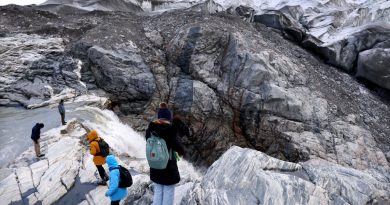Seabirds & their vulnerability to a warming climate: Q&A with researcher Emily Choy

A study released this month found that as the climate changes in the North, some cold-adapted arctic birds are especially susceptible to heat stress.
The study, “Limited heat tolerance in a cold-adapted seabird: implications of a warming Arctic” specifically looked at thick-billed mures and was published on July 7 in the Journal of Experimental Biology. In the paper, the researchers found that mures struggle to dissipate heat and can start showing signs of heat stress at temperatures as low as 21 C.
The research was done in Canada on Coats Island in northern Hudson Bay following reports of mure die-offs in the area on sunny days.
To find out more about the study and its implications, Eye on the Arctic spoke with Emily Choy, a postdoctoral fellow in the Natural Resource Sciences Department at McGill University in Montreal, and the study’s lead author.
Eye on the Arctic: Talk to us a bit about the thick-billed mure. Where is it typically found and what makes it so unique?
Emily Choy: The thick-billed mure is a cold-adapted Arctic seabird species. It tends to breed and forge exclusively in waters 8 C and lower so it’s only found in the higher latitudes. It also tends to forge near sea ice. The colony I study on Coats Island has about 30,000 breeding pairs of mures. They nest on Coats Island and spend their winter off the coast of Newfoundland and Labrador.
So what’s really neat about this species is that they’re quite amazing divers, up to150 metres, so can dive for their prey which is mostly arctic cod and capelin. But they also spend four hours a days flying during the breeding season. So birds flying and diving are an energetic trade off, it’s very difficult to do both. A great example of this is a penguin, which is an amazing diver but has lost its ability to fly. Mures can do both, but they have very, very high energy demands, in particular with their flight , so they’re basically designed and built like a diver but they can fly.

How did you get interested in studying this bird colony in particular?
The die-offs were detected during a 30-year monitoring program of the mure colony at Coats, which was started by Dr. Tony Gaston at Environment and Climate Change Canada. He recorded the die offs in papers were he found that on days that weren’t too hot, like 21 C, mures were panting, and displaying heat stress behaviour such as wings spreading. Quite a lot were actually dying on their nests due to heat stress as well as mosquito parasitism.
I did my masters in sea birds and my PhD in beluga whales and then I moved on to mures. I was very interested in mures as divers but, because I study environmental physiology, I became very interested in the work on heat stress. These die offs made us question how sensitive these birds are to the direct effects of climate change such as warming temperatures.

Talk to us about your findings. What stood out as most significant to you?
The research confirmed, based on all our measurements and traits associated with heat stress, that mures have very limited heat tolerance and are very poorly adapted to heat. But what was surprising was just how poorly adapted they are.
They started displaying signs of heat stress at temperatures as low as 21 C. For some of the measures, like evaporative cooling efficiency which is basically a measure of how well the birds can dissipate heat, they had the lowest measurements ever recorded in birds to our knowledge.
They are one of the most heat-intolerant species. Some of this might be because they have high metabolic rates which is believed to be an adaptation to living in a cold climate. So they produce a lot of heat, but of course, as the Arctic warms this is a is disadvantage when you want to cool down.
What do you want to look at next?
This is one of the first studies to look at the impact of heat stress on arctic birds, or arctic species in general, and it’s the first on a large, cold-adapted sea bird. It definitely raises alarm bells about what the potential impacts of cold-adapted arctic species are to heat.
So there are definitely a lot of questions raised that we would like to follow up on. For example, one of the discoveries was larger birds, or larger mures, are less tolerant to heat than smaller mures. Obviously being large and having a large body size has advantages for mures. They can have deeper dives, and can withstand cold better, but there’s obviously a disadvantage in terms of heat. Maybe in the future, if the climate continues to warm, maybe they’ll be some selected pressure for a smaller body mass, but we don’t know.

Other questions would be looking at the actual temperature the birds are exposed to. The birds are black, have their nests on cliffs and are very exposed to the elements, so we definitely want to look at the impact of solar radiation on them.
Depending on where they are on the cliff, some of them are more exposed to sun than the others. Males and females each take turns spending about 12-hour shifts incubating on their nest. When Tony Gaston was doing some of his work, he found that although the air temperature was 21 C, when he took measurements of the birds’ backs, he found that they could heat up in full sun to 46 C. So that’s a study we’d like to explore, looking at the actual temperature that the birds are exposed to on their nests and how the positioning of their nests and whether they’re in full sun, shade or microclimates, impacts their ability to tolerate heat. And also do some behavioural studies to see what impact heat stress and air temperatures have on the birds’ behaviour.
The big concern around climate change and mures is that they’re not just impacted by one stressor, like heat alone, but also changes in prey and increases in shipping. So our hope is that by understanding the stressors they’re under, there are some ways we might be able to control for, and ease, the impacts on the species.
(The above interview has been edited and condensed)
Write to Eilís Quinn at eilis.quinn(at)cbc.ca
Related stories from around the North:
Canada: New research chair at Laval University to help better understand permafrost changes in Arctic Quebec, Eye on the Arctic
Russia: Oral histories unlock impact of climate change on nomadic life in Arctic Russia, says study, Eye on the Arctic
Sweden: Sweden to lead major Arctic expedition, Radio Sweden
United States: Climate change is worsening water scarcity in rural Alaska says study, Eye on the Arctic



